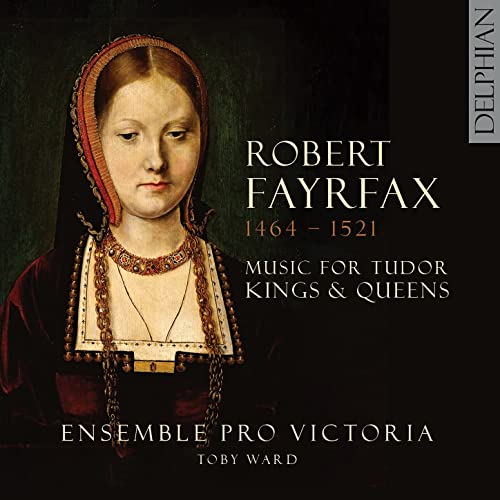Ensemble Pro Victoria
67:07
Delphian DCD34265
Only digital available for now – you can pre-order it HERE.
[These sponsored links help the site remain alive and FREE!]
Oh hooray! Somebody is commemorating the quincentenary of the death of Robert Fayrfax, one of England’s, and the world’s, great composers. Nobody begrudges the attention lavished upon Josquin Despres, the quincentenary of whose passing also falls this year, but Fayrfax is likewise a musical colossus, and these two men are more than equipped to be named together in the same sentence. Although nearly all the pieces on this disc have been recorded before, the selection of material makes for a fascinating programme, and it benefits from being performed by one of Britain’s finest young vocal ensembles, who in turn are supported by musical scholarship of the highest order, led by Magnus Williamson.
The said programme consists of all seven secular songs by Fayrfax which survive intact, one for two voices, the rest for three; three relatively well-known Latin works – Magnificat Regale, Salve regina and Maria plena virtute; and two more Latin works which have required heavy reconstruction – Ave lumen gratiae and the Credo from the Missa Sponsus amat sponsam. This last-mentioned work is the only premiere recording on the disc. (A different edition of the first half of Ave lumen appears on ASV CD GAU 160 sung by The Cardinall’s Musick. Strangely, although a reconstruction of the second half of the motet is sung on the present disc, only the text of the first half is provided in the booklet.) The mass survives in a seriously fragmentary state, spread around several sources, one of which is a lutebook. With major surgery, all the movements have been rendered in a performable, if necessarily provisional, condition edited by Roger Bray, and are available as such from Stainer and Bell. Seemingly the Credo is “the least incomplete movement” (email from Magnus Williamson to the reviewer) and so this was chosen to give some indication of what this intriguing and significant mass might have sounded like in contemporary performances both formal and domestic. Magnus explains in the booklet how he has built upon the initial work of Roger Bray to provide the form of the movement sung and played here. His perceptive and convincing theory about the origin and subsequent history of the mass is also set forth.
The programme is well constructed. This is the first commercial disc to include all of Fayrfax’s surviving songs, which are interspersed among the longer Latin works throughout the recording, which is topped and tailed by two of his finest and best-known liturgical pieces. The Mary antiphon Maria plena virtute concludes the record, one of the most impressive works in the entire Tudor repertory and one that sounds advanced for its time; it is not surprising that in one source it is attributed to Taverner. Probably it is one of Fayrfax’s latest works, composed after he had entered royal service in 1504. Beginning the disc is the Magnificat Regale, among his most recorded works and one of the three works by Fayrfax that survive from the Eton Choirbook. Originally there were six of his works in this magnificent manuscript, but three have been lost altogether; the Magnificat has also been lost from the Choirbook but survives intact elsewhere, Ave lumen gratiae has required the comprehensive reconstructive attention mentioned above, and only Salve regina survives intact in the Choirbook itself. The fact that all three surviving works are included on this disc is another instance of a group of linked works being included on this same record for the first time. The programme is completed by the Credo from the Missa Sponsus amat sponsam which was also mentioned above.
The members of Ensemble Pro Victoria (EPV) patently have their own clear overall concept of Fayrfax’s music. Their sound is radically different from that of The Cardinall’s Musick (TCM) who have recorded – sublimely – nearly all these pieces. EPV sound grainier, with individual voices exhibiting more vibrato except in some extended full passages during the longer Latin liturgical pieces. That said, the Credo sounds almost as though it is barked in certain places. The classic song Sumwhat musyng provides a concise illustration of their different stylistic approach from that of TCM, EPV’S fraught delivery conveying an emotional depth on a par with TCM’s introverted contemplation. One could say that where their repertories coincide, TCM’s interpretations tend to be otherworldly, while those of EPV are of this world. The standard of singing in both cases is very high, and individual preference among listeners might come down to a greater liking either for the ethereal or for the earthly (or even at times earthy). But Fayrfax’s works are great and marvellous enough to withstand varied interpretations, so owners of some or all of TCM’s five Fayrfax discs (Gaudeamus CD GAU 142, 145, 160, 184, 185) could well find EPV’s different approach to Fayrfax rewarding, besides the presence of one and a half Latin works not recorded by TCM. The measured intensity of The Cardinall’s Musick might just suit this music slightly better, but the Ensemble Pro Victoria plough their own furrow with a passionate engagement that does no great disservice whatsoever to Fayrfax’s transcendent music.
Richard Turbet
